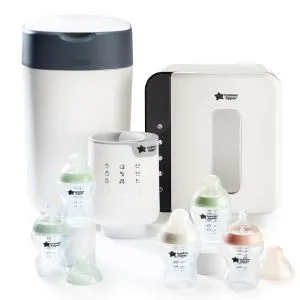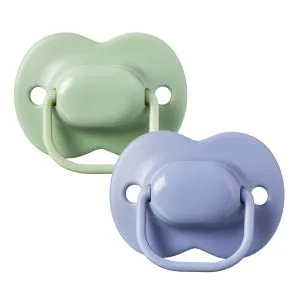
Tommee Tipps
Discover some of the most popular breastfeeding positions and read our helpful breastfeeding tips for helping your baby successfully latch and unlatch.
Finding the Best Breastfeeding Positions for You
When it comes to breastfeeding your baby, there’s no one-size-fits-all 'perfect' position. And it may take a couple of tries before you figure out which breastfeeding positions work best for you and your little one.
Discover some of the most popular breastfeeding positions and read our helpful breastfeeding tips for helping your baby successfully latch and unlatch.
Breastfeeding positions for newborns
There are various breastfeeding positions – and it's a simple case of trying them out to see which works best for you and your little one.
Generally, when you're holding a baby to breastfeed, you should have them on one side, facing towards your breast. Their entire body should be in line and their head shouldn’t be turned to the side.
Using a pillow can make manoeuvring them to your breast and holding them there easier.
Breastfeeding lying down
Breastfeeding while lying down can be a good option for night feeds, afternoon rests, or for mums who're recovering from a C-section, as baby doesn't put any pressure on the stomach as they feed.
If you do breastfeed while lying down, it's important to make sure that there’s no excess bedding or pillows around baby. Lying down breastfeeding positions shouldn’t be done while sitting on a sofa or recliner, due to a risk of suffocation.
Laid-back breastfeeding
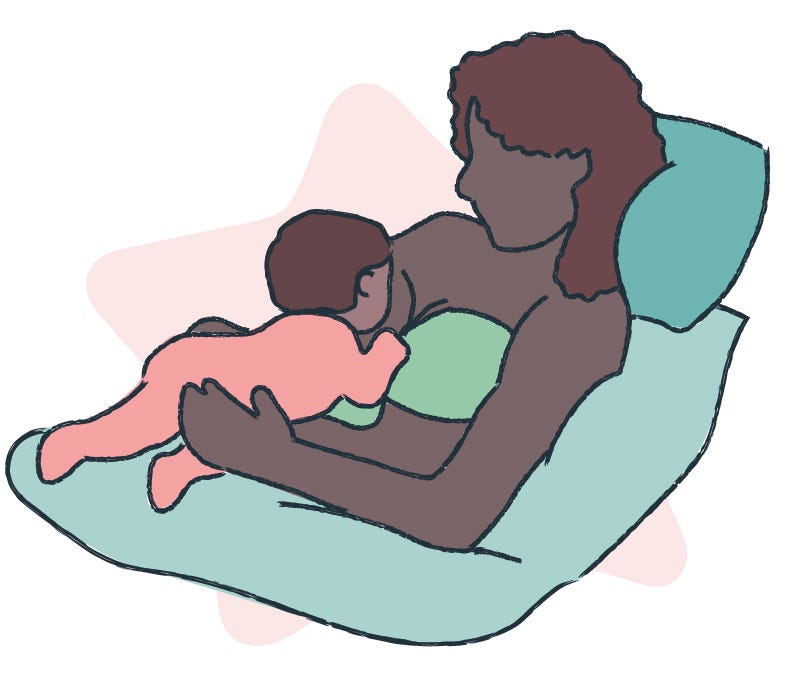
Also known as biological nursing, the laid-back breastfeeding position gives you and your baby snug comfort and support.
Simply lean back on your bed or in a chair and support yourself with pillows in a semi-reclined position. This position encourages your baby to latch on naturally and means you can lie back and relax. If your baby has gas or a sensitive tummy, you may find that a laid-back feeding position will help to relax them.
Side-lying
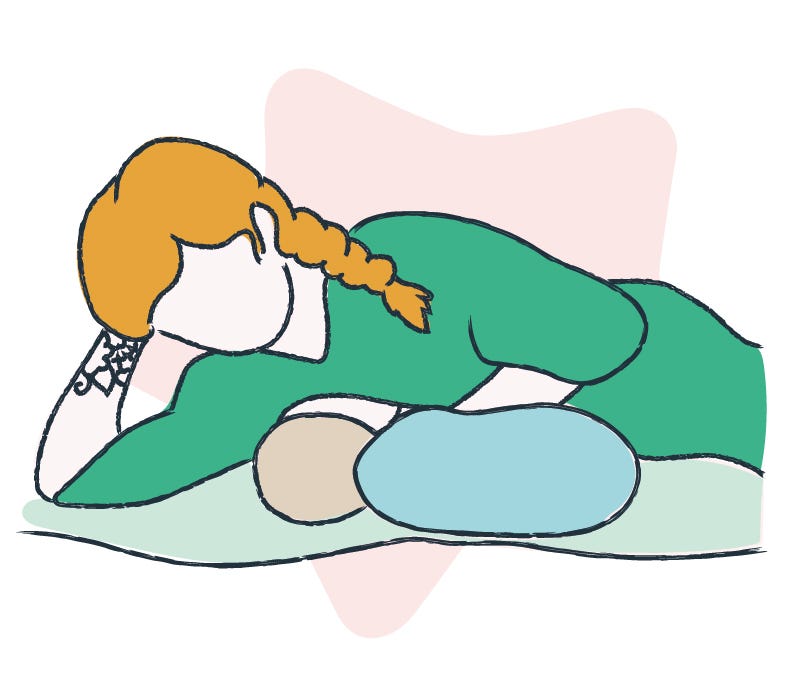
Breastfeeding lying down on your side is another popular position, particularly at nighttime.
You and your baby lie side by side facing each other. Rolling up a blanket and putting it behind your baby’s back will keep them from rolling away from you. Similarly, you can try using a pillow behind your back or between your knees for extra support. You can also cradle your baby with your forearm along their back to help them feed.
This position is especially helpful for those feeding with bigger boobs since it takes the weight off the breast and is easier to get on your baby's level.
Upright breastfeeding positions
There are a variety of upright breastfeeding positions to choose from. Let’s run through them to help you decide which one is right for you and your baby.
Cradle hold
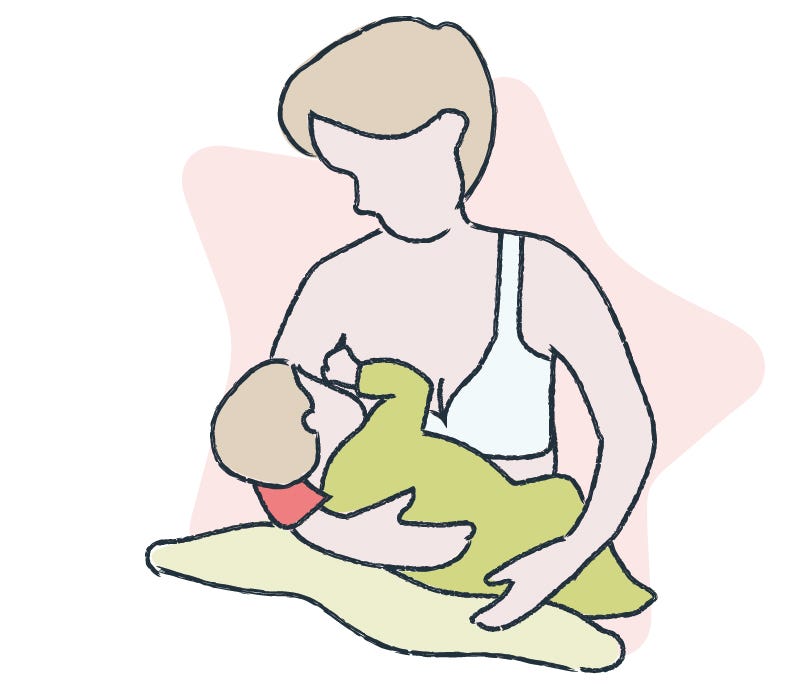
The cradle hold is a classic breastfeeding position, and it’s probably the one that first springs to mind when you think about breastfeeding.
Sit upright and position your baby on their side with their neck resting on your forearm and their body positioned against your stomach. Having a cushion behind you is recommended to avoid back strain.
If you decide to use a breastfeeding pillow on your lap, be sure it doesn't position your baby higher than necessary to avoid them straining to latch. This position can often lead to baby's head being forced into an angle whilst feeding. So, it's best to make sure that baby is positioned in a straight line and not off to the side. Their body should be wrapped around your chest and their legs tucked in.
Cross-cradle hold
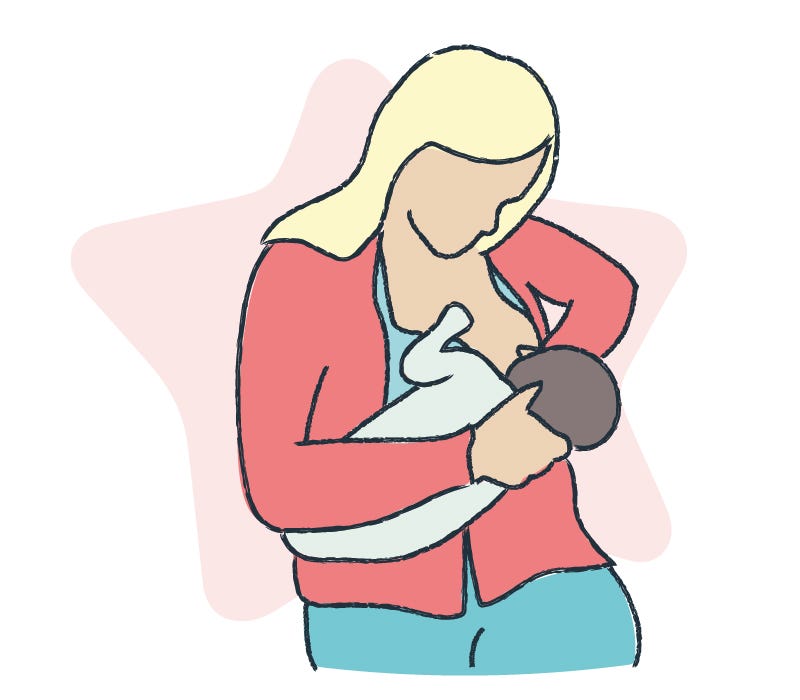
The cross-cradle hold is like the cradle hold, except that your arms switch roles so that your opposite forearm is supporting your baby’s body.
This breastfeeding position is good for newborns or babies with difficulties latching on to the nipple. Simply hold your baby in the arm opposite the breast you’re feeding from (making sure to support their neck and head). With your other hand, support your breast and cradle your baby close to it.
Once baby is latched on and sucking, you can swap arms to help you stay comfortable during longer feeds.
Rugby hold
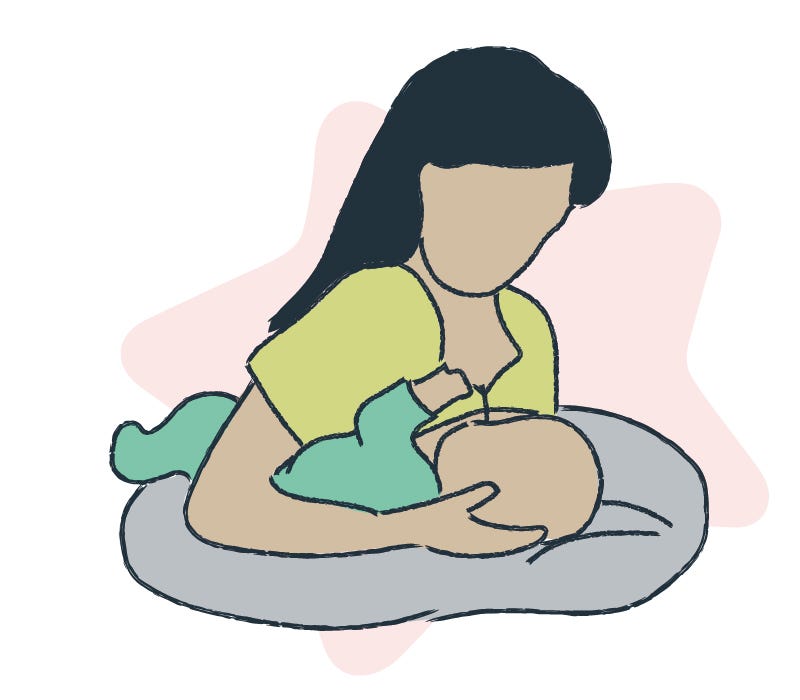
The rugby or football breastfeeding hold (sometimes called the 'clutch position') can be achieved by cradling your baby in your arm – using your palm to support their neck – and nestling them closely against your side with their legs tucked underneath your arm.
This position is good for:
- Newborn babies
- Helping your baby handle your milk flow easier if you have a forceful letdown
- Those feeding multiple babies
- Mums who have smaller boobs
- Mums who are recovering from a caesarean or experiencing sore nipples.
Koala hold
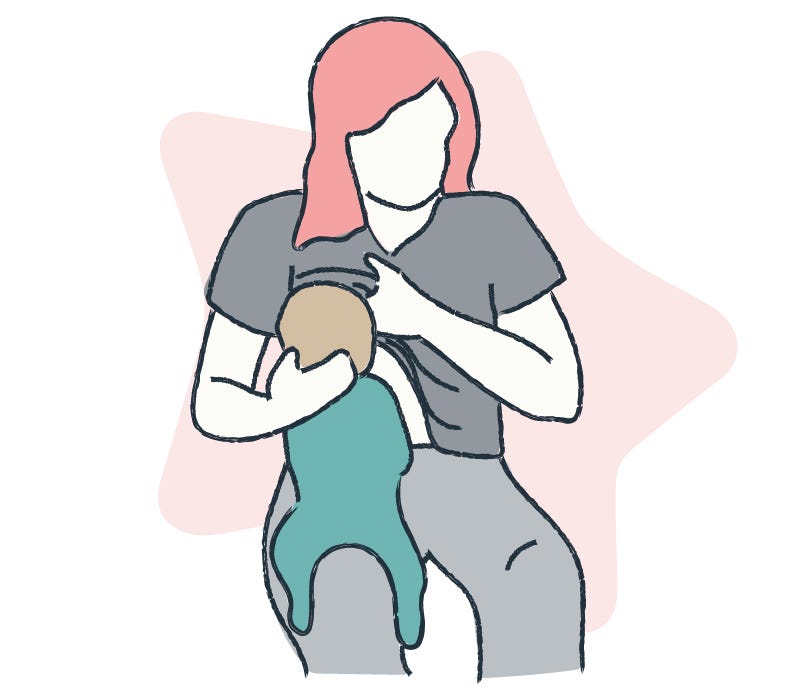
Koala hold – also known as the straddle hold – involves the baby being held in an upright position, either on their mum's lap or with their legs on either side of mum's legs.
This hold can be useful if you have an older baby who likes to look around as they feed. It can also be a good option if you have a fast milk flow and want to slow this down to make it more manageable for your baby.
Different ways to breastfeed: Mother-led and baby-led attachment
There are different ways to approach breastfeeding, and like all aspects of raising a baby, there's no one 'perfect' way to do it.
Baby-led attachment is best to start with, as it offers a natural introduction to breastfeeding. It allows babies to seek out their mum's breasts. Laid-back breastfeeding positions work well for this, as they make it easier for baby to make their way onto the breast independently.
Mother-led attachment helps a baby latch on and involves guiding your nipple to them when they display hunger cues. Breastfeeding positions that work well for mother-led attachment include:
- Football hold
- Cradle and cross-cradle hold
- Koala hold
- Laid back and side-lying holds.
Top tips for successful breastfeeding holds
Now that we've gone through what the different types of breastfeeding positions are, let's cover some top tips for successful breastfeeding.
- Have plenty of skin-to-skin contact with your baby while breastfeeding.
- If you’re feeding twins, it may be easier to feed them separately to start with until you've built your confidence.
- Practising different breastfeeding holds at mum's groups before your baby is born can help to build your confidence.
- Pillows can sometimes help with positioning and offer added comfort.
Laura told us that "there is a lot of support out there for breastfeeding mothers, you just need to ask for it. From the moment that we were on the ward after birth, I was asking the midwives and breastfeeding experts for help. In the following days and weeks, I saw a midwife, heath visitor and a lactation specialist and asked them for advice constantly. You've really got to be your own advocate and ask for help if you need it."
Keeping your baby latched while feeding
Sometimes babies unlatch mid-feed. If your baby unlatches from your breast during feeding, these top tips should help them to latch on again:
- Give them a minute before reattaching as they may just want a rest from feeding
- Hold your baby close
- Position your nipple with your baby’s nose
- Touch your nipple against their top lip so they open their mouth
- Make sure your baby’s chin touches your breast.
How to avoid poor breastfeeding positioning
An improperly positioned baby can mean that your breast milk supply is not properly stimulated, and your baby may not get enough during a feed. Additionally, problems with positioning while breastfeeding can lead to a poor latch, which can cause uncomfortable nipple pain.
Certain breastfeeding positions can be bad for your baby and should be avoided, including:
- Having your baby’s head facing a different direction than their body – their head shouldn’t be turned
- Hunching your body over your baby while feeding
- Holding your baby’s body too far away from your breast.
Breastfeeding positions FAQs
How long should a breastfeeding session last?
The time it takes to breastfeed your baby depends on several factors, such as the speed of your breast milk flow, your baby’s age, and their alertness at the time of the feed. For example, a sleepy baby will likely take longer to feed than a fully rested baby.
A breastfeeding session with your baby might take anywhere between five and 45 minutes. The average feeding often lasts somewhere between 10 and 20 minutes.
However, if your little one is frequently only feeding for five minutes at a time, you may want to encourage them to feed for longer and make sure that their weight gain is sufficient. If you're concerned about your baby's breastfeeding habits, don’t hesitate to get their feeding position and latch checked by your health visitor, midwife or lactation consultant.
What are the signs of a good attachment when breastfeeding?
There are a few signs you can look out for to know if your baby is properly attached while breastfeeding. These include mum and baby being comfortable, and baby’s mouth being open wide against the nipple, with their chin touching the breast, and their cheeks not sucked in. Their jaw should move deeply while they feed, and you should be able to see them swallowing.
Do pillows help with breastfeeding positions?
The truth is, some mums find using a breastfeeding pillow useful, while others don’t.
If you do want to use pillows for support while breastfeeding, make sure that your baby’s head stays level with your breast, and continue to hold and support them while they feed.
Which breastfeeding positions are best if you’ve had a C-section?
The rugby breastfeeding hold can be more comfortable for mums who've had a C-section, as it keeps baby away from the abdominal incision. The laid-back or side-lying positions may also be a more comfortable option than sitting because they don’t put any weight or pressure on your wound.
Sources
- Breastfeeding positions guide: in pictures | Raising Children Network
- Baby-led attachment | Australian Breastfeeding Association
- Positioning – how to hold your baby to breastfeed | Australian Breastfeeding Association
- Signs of an effective attachment | Health and wellbeing | Queensland Government (www.qld.gov.au)
- Breastfeeding Positions and Tips for Mom and Baby (whattoexpect.com)
- Biological Nurturing or Laid Back Breastfeeding - La Leche League International (llli.org)

